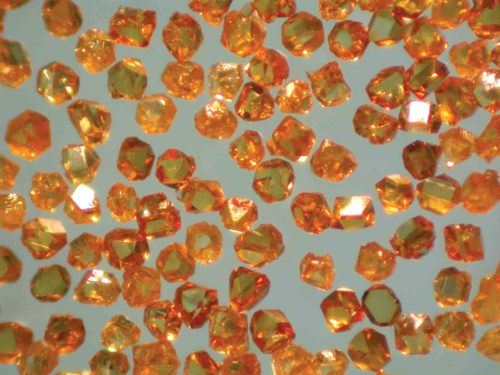
“By encapsulating radioactive material inside diamonds, we turn a long-term problem of nuclear waste into a nuclear-powered battery and a long-term supply of clean energy.”

Synthetic diamond made from carbon-14 could become a long-term electrical power source, according to a team at the University of Bristol.
“There are no moving parts involved, no emissions generated and no maintenance required, just direct electricity generation,” said Professor Tom Scott of the University’s Interface Analysis Centre. “By encapsulating radioactive material inside diamonds, we turn a long-term problem of nuclear waste into a nuclear-powered battery and a long-term supply of clean energy.”
The team has demonstrated a prototype diamond battery using Nickel-63 as the radiation source.
Now it is working to improve efficiency by using carbon-14, which can be extracted from used graphite moderator blocks from nuclear reactors.
Carbon-14 is a β particle (fast electron) emitter, decaying to nitrogen-14.
“Carbon-14 was chosen as a source material because it emits a short-range radiation, which is quickly absorbed by any solid material. This would make it dangerous to ingest or touch with your naked skin, but safely held within diamond, no short-range radiation can escape. In fact, diamond is the hardest substance known to man, there is figuratively nothing we could use that could offer more protection,” said Bristol chemist Dr Neil Fox.
Average fast electron energy is 50keV, and the β particles create successive electron hole pairs due to inelastic impacts with other carbon atoms, generating a cascade of lower energy electrons that are collected at a metal contact on the diamond.
“In conduction terms, diamond is a semiconductor, and like the operation of a silicon solar panel cell, electric current flows when valence electrons are given enough energy to be promoted into the conduction band.” said the University.
Nitrogen decay products build-up in the diamond but don’t destroy its structure because “nitrogen is surprisingly soluble”, according to the University – with a solubility limit close to 2×1018/cm3 in CVD diamond. “It would take hundreds of years for this transformation to become noticeable on the performance of the device mainly because the majority of the current is generated in the bounding – and isotopically pure – clean diamond layers.”
The poly-crystaline diamonds would be made by chemical vapour reposition from carbon-14, then locked up in layers of diamond made from normal carbon (C-12) – the bounding layers mentioned above, resulting in an object that could be handled – emitting less radiation than a banana, said the University.
A possible route to construction include growing the isotopically layered C-14/C-12 diamonds in the lab from high purity gases. “For this we require substantially larger quantities of C-14 methane than we currently have available”, said the University.
Another possible route is to grow nitrogen-doped diamond in the lab and then irradiate it in a reactor to grow-in the C-14 and subsequently deposit clean C-12 diamond on the outside. “This would achieve the same effect but without full isotopic purity. We are about to do this in the research reactor at KURRI in Japan,” said Sussex.
The amount of carbon-14 in each battery has yet to be decided. The team claims that a battery with 1g of carbon-14, would deliver 15 Joules per day, taking 5,730 years (C-14 half-life) to reach 50 per cent power.
Applications in pacemakers, satellites, high-altitude drones and spacecraft are foreseen.
Diamond beta battery at a glance
voltage – 2Vestimated (Ni-63 1.9V measured)
energy – 2.7TJ over first 5,730 years
prototype size – 10 x 10 x 0.5mm (plus electrodes)
temperature – physically stable at 750°C
Recycling nuclear waste
Bristol is proposing converting the C-14 in radioactive graphite blocks to diamond as a potential route to safe disposal.
Heat-treating the blocks can reduced the amount of radioactive carbon-14 in them (as it comes off as a gas, to be turned into diamond), converting the blocks from ‘intermediate level waste (ILW) to ‘low-level waste (LLW).
“Cost estimates for disposing of the graphite waste are £46k/m3 for ILW and £3k/m3 for LLW. Therefore, if the waste processing to remove the C14 reclassifies the waste as LLW, then any cost under £43k/m3 will represent a saving to the UK taxpayer,” said the University, adding that the costs of waste processing to retrieve C14 are unknown but are likely to dominate any cost of creating CVD diamond.